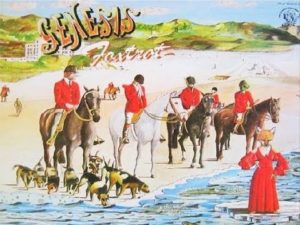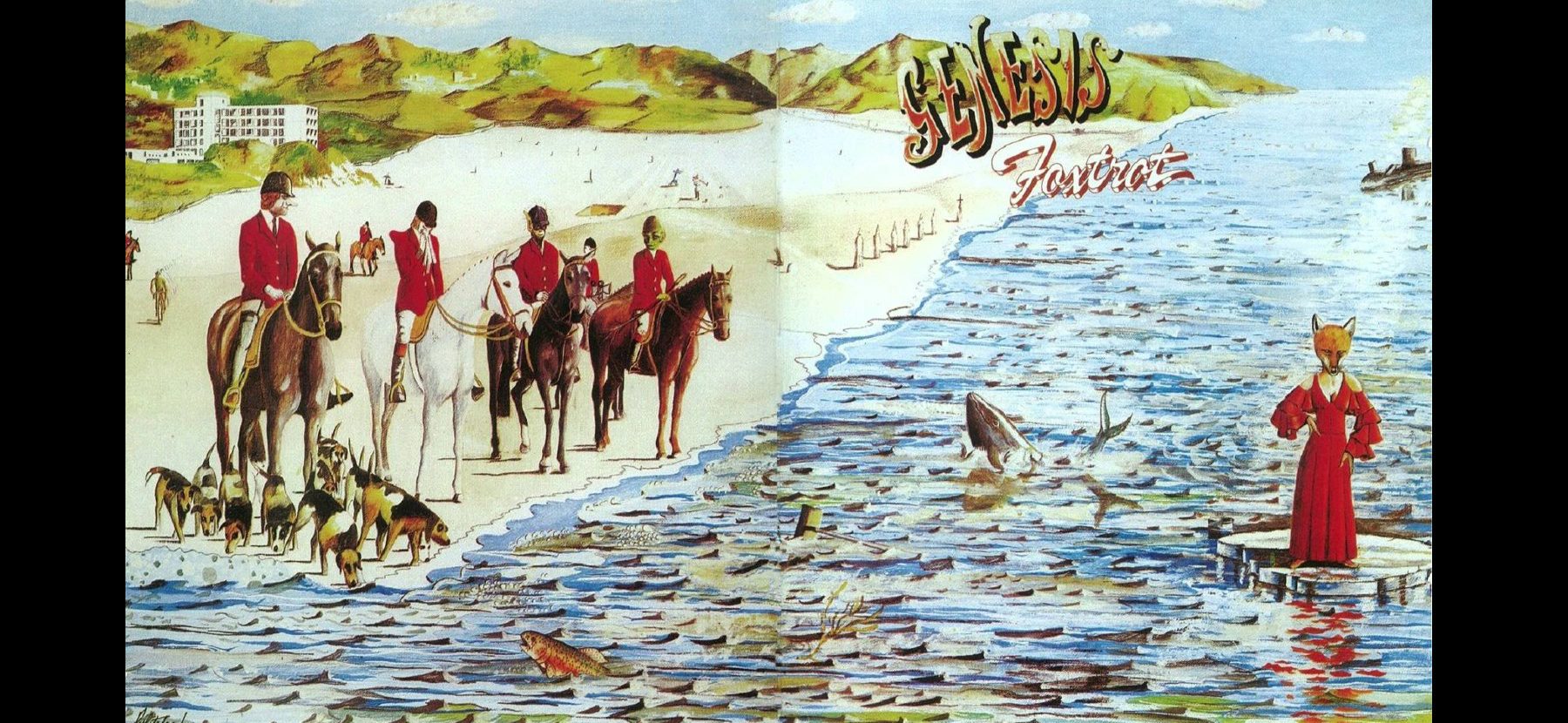Audio Program
The audio program streaming will be available when purchasing the article.
Download
Audio program download will be available when purchasing the article.
We remind you that the audio fragments embedded in the text are to be used when reading the article without listening to the audio program. All these examples are included in the audio program.
Welcome to the fifth edition of the Classic of the Month. Tonight, “Supper’s Ready”…..
There is no better way to start this analysis than by quoting Mark Spicer from his paper: Large-Scale Strategy and Compositional Design in the Early Music of Genesis:
“Supper’s Ready” is formed by 7 scenes or tableaux. I will analyze each “portrait”, discussing the music and the lyrics as they appear. In doing so, the story behind the piece will unfold, and with all the pieces of the puzzle in their place, we will be able to appreciate the greater design of the piece.
In each section, interspersed with the lyrics, I will include the program notes written by Gabriel himself in order to help fans understand the story. These notes were distributed among the audience during Genesis concerts in 1973.
There is one structural aspect of the whole piece that needs to be highlighted now. If you are familiar with Mussorgsky’s “Pictures at an Exhibition” (both the original and ELP’s version) you will know that the author was inspired by a series of paintings (by Victor Hartmann). Mussorgsky included, between some pieces, short interludes called “promenades” that illustrate the moment when the viewer is walking from one picture to the other. “Supper’s Ready” also has “promenades” between some tableaux and will be treated separately. Thus, the analysis will be done based on the following overall structure:
- Lovers’ Leap
- Promenade I
- The Guaranteed Eternal Sanctuary Man
- Promenade II
- Ikhnaton and Itsacon and their Band of Merry Men
- Promenade III
- How Dare I be so Beautiful?
- Willow Farm
- Promenade IV
- Apocalypse in 9/8 (co-starring the Delicious Talents of Gabble Ratchet)
- As Sure as Eggs is Eggs (Aching Men’s Feet)
Before jumping into the music, let’s highlight some features of the art cover, done by Paul Whitehead. In the “Resources” section you will find a link to an article where Paul Whitehead himself describes the cover.

Note that in the back you can see the croquet scene depicted in ”Nursery Crime”. This was included in order to provide continuity to the aesthetics established by Whitehead in the two previous albums.
Quoting Whitehead:
There are two direct references to lyrics in the album: the four horsemen of the apocalypse and the “Six saintly shrouded men move across the lawn slowly. The seventh walks in front with a cross held high in hand.” The fox is able to escape the chase by hopping on an ice block and moving away from the shore. In the 70’s, in the US pretty women were known as “foxes”, so here we have the fox, disguised as a sexy lady. If you look closely, you will see that the first horse to the right is clearly “excited” by this sexy fox 😉

As a final prelude before starting with “Lover’s Leap”, let me tell you a short story. Although I’m not a collector, I happen to own an autographed version of the book “Genesis, I Know What I like” by Armando Gallo published in 1980. This is an excerpt of the book (page 49) where Gabriel tells Gallo a story that lies the foundation for the piece, and helps in understanding the whole conceptual framework:
Let’s proceed with the musical analysis of “Supper’s Ready”.
Lovers’ Leap
Gabriel’s description of this section is:
The first thing to point out is that “Supper’s Ready” has no opening section – no intro. This is very unusual in long conceptual pieces. From the first beat of the first measure, Gabriel starts to sing with instrumental accompaniment. Notice that Gabriel’s voice is doubled, the second voice an octave higher. Since the lyrics have been written in first person, this effect could very well represent the split into 2 different entities that is described in the lyrics. The structure of this section is:
A-B-Interlude-A-B-Coda
Let’s identify each section while we listen to this fragment:
A:
Walking across the sitting-room, I turn the television off.
Sitting beside you, I look into your eyes.
As the sound of motor cars fades in the night time,
I swear I saw your face change, it didn’t seem quite right.
…And it’s
B:
hello babe with your guardian eyes so blue
Hey my baby don’t you know our love is true.
Brief instrumental interlude
A:
Coming closer with our eyes, a distance falls around our bodies.
Out in the garden, the moon seems very bright,
Six saintly shrouded men move across the lawn slowly.
The seventh walks in front with a cross held high in hand.
…And it’s
B:
…hey babe your supper’s waiting for you.
Hey my baby, don’t you know our love is true.
Coda:
I’ve been so far from here,
Far from your warm arms.
It’s good to feel you again,
It’s been a long long time. Hasn’t it?
Notice that the first verse is a very close description of Peter and Jill’s experience. The only major change is the setting – from the bedroom to the sitting room. Also, notice that the doubled voice separated by an octave only occur during sections “A”. It is a very effective way to describe the fact that both male and female are being affected by the same supernatural phenomena.
The reference to Supper as a religious experience (obviously The Last Supper) is reinforced from the very beginning of the song with the strong image of 7 saintly shrouded men, the front man carrying a cross. Also note there are 7 of them – the piece has 7 tableaux…
Finally, I believe that more than “the bodies of another male and female” as described by Gabriel, what we have here is a regression to a past life when these lovers had already met. Read again the lyrics of the coda with this interpretation:
I’ve been so far from here,
Far from your warm arms.
It’s good to feel you again,
It’s been a long long time. Hasn’t it?
From a musical point of view, Mark Spicer points out a clever modulation from E to B flat (a distant key) to accompany the phrase “I swear I saw your face change”.
The main function of the short instrumental interlude is to take the key back to E, in order to repeat A with the second verse.
Promenade I
There is a form used during the baroque period that perfectly describes the form of this promenade: Chaconne In essence a Chaconne is used as a vehicle for doing variations over a repeated short harmonic progression. Notice that the two acoustic guitars are always shifting between the same two arpeggios. At the beginning the guitars are played solo, to establish this harmonic progression. Try to listen only to the guitars during the entire section until the end of the flute solo. You will see that they don’t move away from these two arpeggios. This Chaconne has four variations:
- Choral arrangements (first time alone, second with keyboard embellishments)
- Keyboard solo
- Guitar and bass solo
- Flute solo
After the flute solo, the guitars modulate to G minor in preparation for the tonality of the next tableau (A minor), so this section can be regarded as the intro to the second tableau.
The Guaranteed Eternal Sanctuary Man
Gabriel’s description of this section is:
The structure of this section is:
Intro-A-B-A-B-Coda
The analysis of Starless included an explanation of a harmonic resource known as “harmonic pedal”. Notice that in the “A” sections, Rutherford keeps a bass ostinato on the note A, while the harmony moves. This is another great example of a harmonic pedal used very effectively. On the “B” sections the pedal is broken and the bass supports the ingenious harmonic changes that support the lyrics.
Let’s identify each section while we listen to this fragment:
If you want to read the rest of the article, you need to buy it:
Resources
This analysis would not have been possible without the solid foundation laid by Mark Spicer in his work: “Large-Scale Strategy and Compositional Design in the Early Music of Genesis”.
Paul Whitehead’s description of the artwork of Foxtrot can be found here.
Foxtrot art cover images were taken directly from my personal copies of the album.
The background music used is “Bayreuth Return” from the album “Timewind” by Klaus Schulze.
Here’s the live version of Supper’s Ready in its original format at “Live in Shepperton in 1973”:
This is the link to the video in YouTube
This is a wonderful animated version of “Supper’s Ready” created by Nathaniel Barlam:


